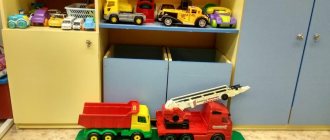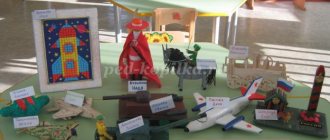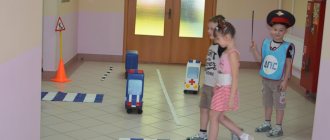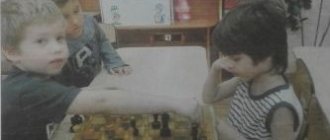Development of gaming activities in the light of the Federal State Educational Standard
Selecting a game during which tasks will be solved - didactic, educational, developmental, socializing.
Taking into account the characteristics of the participants in the game.
Accounting for the time of the game.
In the modern classification of games, games with fixed, open rules and games with hidden rules are distinguished.
N.A Korotkova identifies the following forms of play in the educational process:
1.Game as a cultural practice: free story game, free game with rules.
2.Game as a pedagogical form: didactic story game, didactic game with rules.
Playful learning is guided by a complex of child motives:
Cognitive - interest in the material, the novelty of events.
Affiliation is the desire to establish or maintain relationships with peers and the teacher, to contact and communicate with them.
Procedural - substantive - incentive to activity by the content of the activity, and not by external factors.
There are three types of motivation:
1.Game
2. Motivation in terms of helping an adult
3.Motivation of personal interest.
The first type is play motivation - “Help the toy”,
the child achieves the learning goal by solving problems with toys. Creating this motivation is based on this scheme: 1. You tell them that the toy needs help, and only children can help them. 2. You ask the children if they agree to help the toy. 3. You offer to teach children to do what the toy requires, then the explanation and demonstration will interest the children. 4. While working, each child should have his own character - a ward (a cut-out, toy, drawn character to whom he provides assistance. 5. The same toy - the ward evaluates the child’s work and always praises the child. 6. At the end of the work, it is advisable that the children played with their charges.
With this motivation, the child acts as an assistant and protector, and it is appropriate to use it for teaching various practical skills.
The second type of motivation is helping an adult - “Help me.”
Here, the motive for children is communication with an adult, the opportunity to gain approval, as well as interest in joint activities that can be done together. Creating motivation follows the following scheme: You tell the children that you are going to make something and ask the children to help you. Wondering how they can help you. Each child is given a feasible task. At the end, you emphasize that the result was achieved through joint efforts, that everyone came to it together.
The third type of motivation is based on the child’s internal interest.
This motivation encourages children to create objects and crafts for their own use or for their loved ones. Children are sincerely proud of their crafts and willingly use them. The creation of this motivation is carried out according to the following scheme: 1. You show the children some kind of craft, reveal its advantages and ask if they would like to have the same one for themselves or for their relatives. 2. Next, show everyone how to make this item. 3. The completed craft is given to the child. Pride in the work of your own hands is the most important basis for a creative attitude to work. If a child is already busy with some activity of interest, and therefore already has the necessary motivation, you can introduce him to new ways to solve problems.
MAGAZINE Preschooler.RF
Article “Organization of play activities of preschool children at different age stages”State budgetary educational institution of the Samara region, basic secondary school No. 9 named after Hero of the Soviet Union I.D. Vanichkin of the city of Novokuybyshevsk, urban district Novokuybyshevsk, Samara region, structural unit “Kindergarten “Voice Voices”
- Zhuravleva Marina Vladimirovna, senior teacher
- Presnyakova Valentina Petrovna, teacher
GBOU secondary school No. 9 of Novokuybyshevsk structural unit “Kindergarten “Voice Voices” 2022.
Play is an intrinsically valuable form of activity for a preschool child. According to L.S. Vygotsky, O.M. Dyachenko, A.P. Usova, replacing play with other types of activity impoverishes the imagination of a preschooler, which is recognized as the most important age-related neoplasm.
The game is a cross-cutting mechanism for the development of a child (clause 2.7. Federal State Educational Standard for Education), through which the content of five educational areas is implemented: “Social and communicative development” ; "Cognitive development" ; "Speech development" ; “Artistic and aesthetic development” ; "Physical development" .
Play is the main activity of children, as well as a form of organizing children's activities. The specific content of play activities depends on the age and individual characteristics of children, is determined by the tasks and goals of the Program, this is reflected in the Standard of Preschool Education. In paragraph 2.7. The Federal State Educational Standard for Preschool Education defines the features of the development of a child’s play activity:
- in infancy (2 months - 1 year) direct emotional communication with adults, manipulation with objects...
- at an early age (1 year - 3 years) - object-based activities and games with composite and dynamic toys... communication with an adult and joint games with peers under the guidance of an adult...
- for preschool children (3 years - 8 years) - gaming activities, including role-playing games, games with rules and other types of games, communicative (communication and interaction with adults and peers).
For the development of a child, it is important to develop play activities, since this will allow the formation of social and normative age characteristics to be achieved (clause 4.6 of the Federal State Educational Standard for Education):
the child masters the basic cultural methods of activity, shows initiative and independence in various types of activities - play, communication, cognitive and research activities, design, etc.; is able to choose his occupation and participants in joint activities;
the child actively interacts with peers and adults, participates in joint games. Able to negotiate, take into account the interests and feelings of others, empathize with failures and rejoice in the successes of others, adequately expresses his feelings, including a sense of self-confidence, tries to resolve conflicts;
the child has a developed imagination, which is realized in various types of activities, and above all in play; the child knows different forms and types of play, distinguishes between conventional and real situations, knows how to obey different rules and social norms;
the child has a fairly good command of oral speech, can express his thoughts and desires, can use speech to express his thoughts, feelings and desires, and construct a speech utterance in a communication situation.
There are several classifications of games.
Classification of games for preschool children (according to E.V. Zvorygina and S.L. Novoselova)
- Games initiated by the child(ren):
Independent games: Play - experimentation
Independent story games: plot-display games; plot - role-playing; director's; theatrical;
- Games initiated by an adult:
Educational games: Plot-didactic; movable; musical and didactic;
Leisure games: games - entertainment; intellectual; festive - carnival; theatrical - staged;
- Games that come from historically established traditions:
Traditional or folk
Requirements for playing the game:
When playing with children, an adult can have two main strategies. An adult can organize the game himself based on a pre-thought-out general direction of the plot and prepared subject-game materials, or he can join the children already playing. He participates with the children in the game on an equal basis and can influence the content and general course of the game in the same ways that other players use. In a story game, he can come up with a plot for the game, come up with an interesting proposal for its plot continuation, introduce a new character into the game, create a problematic situation, etc.
Directions and tasks of game management
Enrichment of game content
- Encourage students to transfer events from everyday life into the game and thereby master the purpose and properties of objects.
- To promote the ability to set a variety of game tasks.
Formation of substantive methods for solving game problems
3. Enrich extensive play actions with toys with a variety of content.
4. Timely form game actions with substitute objects.
5. Encourage the use of play actions with imaginary objects.
6. Lead to an understanding of the replacement of individual game actions with words.
7. Encourage children to use a variety of subject-based methods to solve assigned game problems.
Development of independence
8. To develop each child’s independence in setting a variety of game tasks.
9. Encourage children to independently choose various subject methods for solving assigned game problems.
Encouraging interaction in the game
10. Encourage interest in peer games.
11. Teach them to play without interfering with each other.
By older preschool age, the child’s play becomes “polythematic . The game becomes an independent activity. Children always determine the concept of the game themselves or support the proposal of their peers. They set game tasks on their own.
Since gaming methods of displaying the world around them are sufficiently developed, children can easily cope with the choice of the most appropriate objective and role-playing methods for solving game problems for a specific gaming situation.
Role-playing actions in the game are accompanied by role-playing speech, at the initial stage of the plot-role-playing game - role-playing statements (area “Speech development” , “Social and communicative development” , Federal State Educational Standard for Education). As life experience enriches the development of sound and intonation culture of speech, role-playing actions become more diverse, which directly depends on children’s ideas about the world around them.
It is not recommended to specifically teach children certain game actions. It is important that children themselves come up with what role-playing actions to include in the game, only in this case the game will be truly creative.
In older preschool age, play becomes an independent activity. Players try to independently resolve conflicts that arise regarding the game.
Increasing the complexity of game management tasks
Directions and tasks of game management
Game content enrichment
- Enrich the themes of games, promote the emergence of interesting ideas, and set reproductive and proactive game tasks for their implementation.
- Encourage to display in games a variety of adult actions, relationships, and communication between people
Ways to solve game problems
3. Encourage originality and independence in the use of objective methods for solving game problems.
4. Strengthen emotional expressiveness and diversify the role-playing actions used to display the role taken.
5. Encourage to take initiative in communicating with adults and peers about the game, promote the emergence of role-playing statements and role-playing conversation
Interaction in the game
6. Encourage peers to set game tasks.
7. Teach children to accept play tasks set by their peers, or tactfully refuse them, and agree on play interaction.
8. Maintain long-term interaction in the game
Independence
9. Continue to develop independence in choosing diverse, interesting ideas and in setting various game tasks for their implementation.
10. Encourage the choice of original subject and role-playing ways to implement ideas in the game.
11. Accustom yourself to negotiate with peers in the game
Planning a game by type of activity throughout the entire educational process can be organized as follows:
- Continuous educational activities will include a variety of didactic games in accordance with the content of educational work in relevant areas.
- Educational activities during the day involve the organization of leisure, active, theatrical games, games with rules, as well as the organization of story-based games together with the teacher, which help enrich the gaming experience of children. Here the teacher acts as a play partner, a bearer of play culture, which he passes on to children in the process of joint activities.
- Independent activity is accompanied by the organization of pedagogical support for amateur children's games (role-playing, directorial, experimental games), as well as games with rules, outdoor, leisure, and folk organized on the initiative of the children themselves. The teacher encourages the manifestation of a variety of play activities, initiative, and independence; provides the opportunity to freely choose topics, partners, methods and means of implementing one’s own activities. This creates conditions for the formation of age-related neoplasms.
Organization of a subject-spatial developmental environment for organizing gaming activities
One of the basic principles of preschool education (FSES DO) is the amplification (enrichment) of the conditions for the development of preschool children. Therefore, in the third section of the Standard - “Requirements for the conditions for the implementation of the basic educational program of preschool education”, among the conditions necessary to create a social situation for the development of children corresponding to the specifics of preschool age, the following is emphasized:
- creating conditions for children to freely choose activities and participants in joint activities;
- supporting children's initiative and independence in various types of activities (play, research, design, cognitive, etc.);
- supporting spontaneous play of children, enriching it, providing play time and space.
This is the most important part of the work of teachers, the implementation of which determines the successful development of the child, which will allow the teacher to achieve the formation of target guidelines outlined in the Standard.
The requirements of the Federal State Educational Standard for Educational Education for a developing subject-spatial environment determine that:
- The developing subject-spatial environment ensures maximum realization of the educational potential of the space of the Organization, Group, as well as the territory adjacent to the Organization or located at a short distance, adapted for the implementation of the Program (hereinafter referred to as the site), materials, equipment and inventory for the development of preschool children in accordance with the characteristics of each age stage: For children of the third year of life there is a free and large space where they can be in active movement - climbing, riding. In the fourth year of life, a child needs a developed center of plot-role-playing games with bright features of attributes. In middle and senior preschool age, there is a need to play with peers, to create your own world of play (director’s play: small toys, construction sets, models, etc.), in addition, in the subject-development environment, the formation of psychological formations in different years of life should be taken into account .
- A developing subject-spatial environment should provide the opportunity for communication and joint activities of children (including children of different ages) and adults, physical activity of children, as well as opportunities for privacy.
The developing subject-spatial environment must meet the requirements of the CE Standard.
The state’s social order for the education system is formulated in the main regulatory documents - the Law of the Russian Federation “On Education” , the Federal State Standard for Preschool Education - this is the education of an initiative, responsible person, ready to make independent decisions in a situation of choice. Each type of activity of a preschool child has a unique impact on the development of different components of independence, for example, play contributes to the development of activity and initiative.
| Next > |








